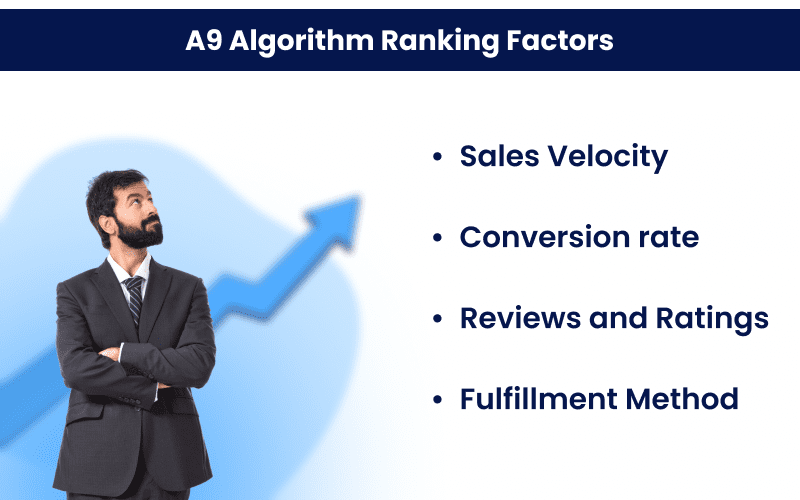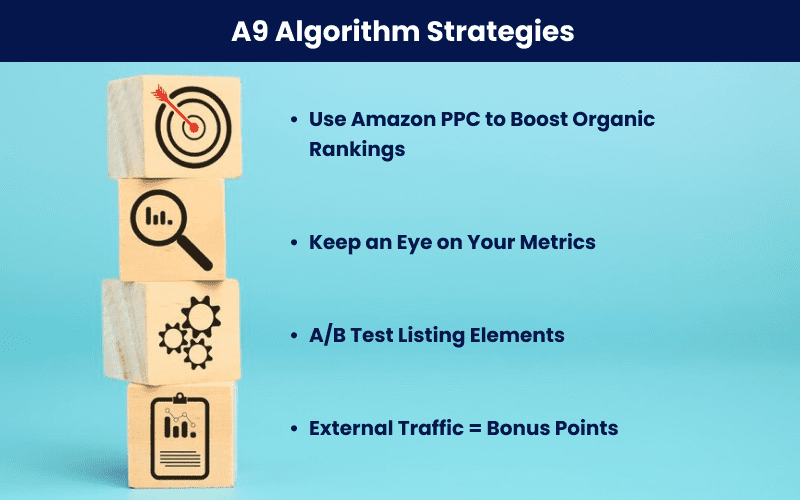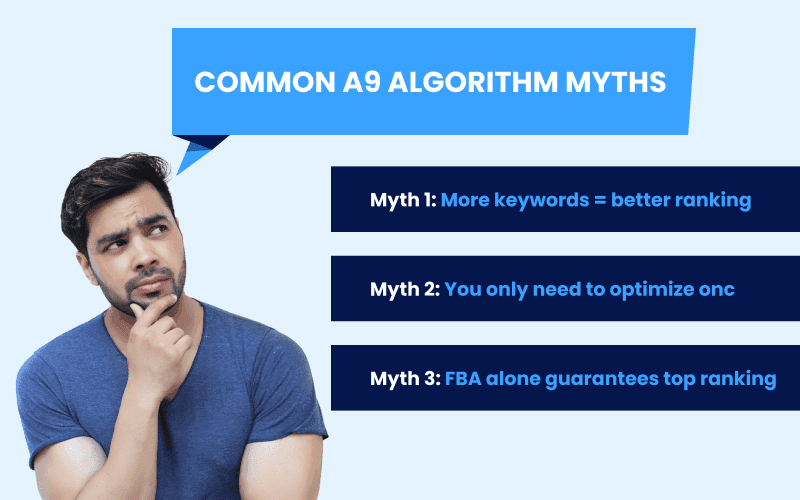
If you’ve ever listed a product on Amazon and wondered why it’s not showing up on the first page, or worse, not showing at all.
Well, selling on Amazon can feel like a never-ending game of chess, and if you don’t understand the rules, you won’t win. One of the most important rules? Understanding Amazon’s A9 algorithm.
Let’s dive deep into the A9 Amazon algorithm, how it works, and what you can do to master it for higher rankings and more sales.
What is the A9 Algorithm?
Think of the A9 algorithm as Amazon’s secret sauce. It’s the behind-the-scenes formula that determines which products show up when someone types something into the search bar.
However, unlike Google’s algorithm, which tries to serve you the best possible answer, Amazon’s A9 is about helping shoppers find the best product. That little difference makes a big impact.
So, the better you can align your listings with what A9 Amazon optimization looks for, the higher your products will appear and the more likely shoppers will buy from you.
Why Should You Care About A9?
Ranking higher means more visibility, which means more sales.
- 70% of Amazon shoppers never go past the first page.
- 35% of shoppers click on the first product they see.
- Conversion rate jumps by over 3X when products are listed in the top 3 results.
So yes, where you rank matters. A lot.
How Does the A9 Algorithm Work?
Amazon hasn’t released an exact blueprint, but after years of research, experiments, and seller experience, we can watch out for a few things for sure.
Relevance is Everything
A9 Amazon starts by matching keywords in the user’s search with your listing. That’s why keyword optimization is the foundation of everything you do on Amazon.
Performance Metrics Influence Rankings
Like every other SEO, Amazon SEO wants to make money out of the traffic. So, it boosts products that are more likely to sell.
Metrics that matter:
- Click-Through Rate (CTR)
- Conversion Rate (CVR)
- Sales Velocity
- Product Reviews and Ratings
Customer Experience Matters
Positive experiences = more sales = higher rankings.
This means shipping speed, accurate descriptions, and minimal returns play a big role.
How to Master the A9 Algorithm?
Now, the question is, how do you master Amazon’s A9 algorithm and get your products in front of more buyers? Let’s break it down step by step.

Step 1: Nail Your Keyword Strategy
If you don’t have the right keywords, you’re invisible in Amazon’s SEO algorithm.
Tips:
- Use tools like Helium 10, Jungle Scout, or Amazon’s search bar for keyword research.
- Focus on both high-volume and long-tail keywords.
- Place keywords in the title, bullet points, product description, and backend search terms.
Step 2: Optimize Your Product Title
Your title is the most important piece of real estate on your listing.
Best practices:
- Start with the primary keyword.
- Include the brand name, key features, and specs.
- Keep it readable
- Don’t just keyword stuff.
Step 3: Bullet Points That Sell (and Rank)
Your bullet points do double duty: they help your rankings and help your customers decide.
Tips:
- Use important keywords, naturally.
- Highlight unique selling points.
- Address pain points and benefits.
Step 4: Write a Compelling Product Description
Here’s your chance to tell your product’s story. Amazon A+ Content can also help boost conversions.
Tips:
- Break it into short paragraphs or use bullet points.
- Use emotional language when possible.
- Include relevant keywords.
Step 5: Use Backend Search Terms Wisely
You get 249 bytes (not characters) to include keywords Amazon doesn’t show publicly.
Do:
- Add misspellings, synonyms, and related terms.
- Avoid repeating keywords already in the title or bullets.
- Leave out punctuation and stop words.
Top Ranking Factors in A9 Algorithm
If you want your product to show up on page one, you need to know what Amazon’s A9 algorithm cares about. These factors can make or break your rankings, from how fast your item sells to how happy your customers are.
Here are a few ranking factors to consider for Amazon marketing:

Sales Velocity
The more you sell, the more A9 pushes you up. That’s why product launches and early sales are so crucial.
Conversion Rate
Your listing needs to turn visitors into buyers. High-converting listings get better placement.
Boost CVR by:
- Using high-quality images (including lifestyle shots)
- Offering competitive pricing
- Answering FAQs in the listing
Reviews and Ratings
More positive reviews = higher trust = better rankings. It’s that simple.
Tip: Use Amazon’s “Request a Review” button and follow up with buyers via email (following Amazon’s terms).
Fulfillment Method (FBA vs. FBM)
FBA (Fulfilled by Amazon) often gets a boost because it guarantees Prime shipping and reliable service.
Advanced Tactics to Dominate A9 in 2025
To be in the game, you need to have an Amazon SEO strategy. Let’s discuss a few advanced tactics to push past plateaus and give the A9 algorithm exactly what it requires for better ranking.

Use Amazon PPC to Boost Organic Rankings
Strategic Amazon brand marketing using ads, or partnering with an Amazon PPC service provider, can boost visibility and drive sales.
Focus on:
- Branded keywords for protection
- Long-tail keywords for conversions
- Competitor keywords to steal market share
A/B Test Listing Elements
Use Amazon Experiments (Manage Your Experiments) to test different titles, images, and descriptions.
External Traffic = Bonus Points
Send social media, influencers, or Google Ads traffic to your Amazon advertising optimization. Amazon loves outside attention.
Keep an Eye on Your Metrics
Track Amazon conversion rate, sessions, sales rank, and reviews regularly. Tools like Seller Central analytics and third-party dashboards help.
Common A9 Myths

Amazon’s algorithm can feel like a bit of a mystery. You’ve probably heard a bunch of “tricks” or rules that promise to boost your rankings. But not all of them are true.
Let’s clear the air and break down some of the biggest myths about the A9 Amazon algorithm:
Myth 1: More keywords = better ranking
Truth: Relevance > quantity. Too many keywords can hurt readability and confuse the algorithm.
Myth 2: You only need to optimize onc
Truth: Optimization is ongoing. Your competition, keywords, and customer behavior are always changing.
Myth 3: FBA alone guarantees top ranking
Truth: FBA helps, but without strong listings and good metrics, it’s not enough.
How Long Does It Take to See Results?
This depends on:
- How competitive your category is
- How optimized is your listing?
- Whether you’re running ads
- Your sales volume
Typically, you may start seeing improvements in 2-6 weeks after fully optimizing your listing and launching PPC.
Final Thoughts
Mastering the A9 Amazon algorithm is not about gaming the system. It’s about aligning your listings with what Amazon brand marketing (and its shoppers) want. When you:
- Do your keyword research
- Optimize every element of your listing
- Keep customers happy
- And focus on performance metrics
You’ll start climbing the rankings and, more importantly, making more sales. Also, remember optimization is not a one-time task. Stay updated, keep testing, and adjust with the market.








